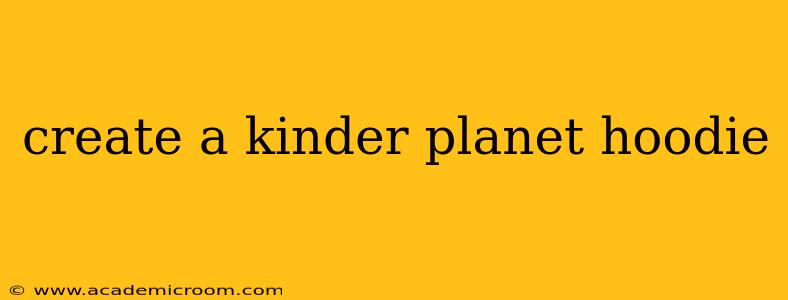Create a Kinder Planet Hoodie: A Guide to Sustainable Style
The desire to create a Kinder Planet extends beyond our daily actions; it's a philosophy that can be woven into our very clothing choices. Creating a hoodie that reflects this commitment requires careful consideration of materials, production processes, and ethical sourcing. This guide will walk you through the steps involved in designing and producing a truly sustainable Kinder Planet hoodie.
1. Choosing Sustainable Materials: The Foundation of a Kinder Planet
The most significant impact on the planet's health comes from material selection. Avoid conventional cotton, notorious for its high water and pesticide usage. Instead, explore these eco-friendly alternatives:
-
Organic Cotton: Grown without harmful pesticides and fertilizers, organic cotton reduces environmental damage and protects farmer health. Look for certifications like GOTS (Global Organic Textile Standard) to ensure authenticity.
-
Recycled Cotton: Made from pre-consumer or post-consumer textile waste, recycled cotton dramatically reduces the demand for virgin materials and minimizes landfill waste.
-
Hemp: A remarkably durable and fast-growing plant, hemp requires minimal water and pesticides. It also boasts excellent breathability and softness, making it ideal for hoodies.
-
Tencel (Lyocell): Derived from sustainably harvested wood pulp, Tencel is a biodegradable and incredibly soft fabric. Its closed-loop production process minimizes water pollution.
-
Recycled Polyester: While not a natural fiber, recycled polyester reduces reliance on petroleum-based virgin polyester, significantly lowering its environmental footprint. Look for recycled content percentages.
2. Ethical Production: Ensuring Fair Labor Practices
A truly Kinder Planet hoodie goes beyond the materials; it necessitates ethical production. Consider these factors:
-
Fair Trade Certification: This certification guarantees fair wages, safe working conditions, and community development for garment workers.
-
Transparency in the Supply Chain: Support brands that openly communicate where their materials are sourced and how their garments are made. This fosters accountability and prevents exploitation.
-
Local Production: When possible, choose manufacturers closer to home to reduce transportation emissions and support local economies.
3. Design and Production Details: Minimizing Waste
The design and production process should minimize waste:
-
Zero-Waste Patterns: Designers are increasingly exploring zero-waste patterns that maximize fabric utilization and minimize textile scraps.
-
Durable Construction: Invest in high-quality stitching and robust materials to extend the lifespan of the hoodie, reducing the frequency of replacement.
-
Sustainable Packaging: Avoid excessive packaging and choose eco-friendly materials like recycled cardboard or biodegradable alternatives.
4. What About the Printing Process?
The printing method you choose significantly impacts sustainability. Consider these options:
-
Water-based inks: These inks are less toxic and have a lower environmental impact than plastisol inks.
-
Eco-friendly dyes: Look for dyes made from natural sources or those with minimal chemical content.
-
Digital printing: Often uses less water and energy than screen printing.
5. How to Find a Kinder Planet Hoodie (or make one yourself!)
Numerous brands are now committed to sustainable practices. Research brands known for their ethical and environmentally responsible production methods. Look for certifications and transparency statements. Alternatively, consider upcycling an existing hoodie or purchasing from ethical clothing resale platforms. If you're feeling adventurous, you can even create your own Kinder Planet hoodie following the guidelines above!
By carefully considering the choices made at every step of the process, from material selection to production and packaging, you can create a hoodie that truly reflects a commitment to a Kinder Planet—a garment that is both stylish and sustainable.
